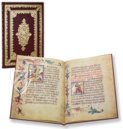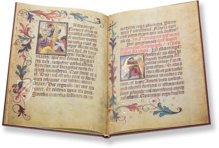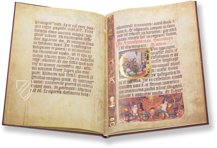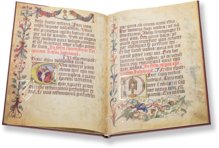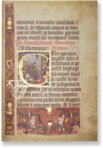Pannonhalmi Evangelistarium
(under 1,000€)
The Pannonhalmi Evangelistarium belongs among Hungary’s most beautiful manuscripts. It originated from the beginning of the 16th century in the west-Hungarian Benedictine Abbey of Pannonhalma and contains text passages from the four Gospels. Their illumination – 22 gorgeous historiated initials and bordures richly adorned with animals and flowers – is characterized by multiple European influences ranging from the Italian Renaissance to Flemish Gothic to Dürer’s Small Passion.
Pannonhalmi Evangelistarium
Pannonhalma in western Hungary, not far from Raab, has been an important name in the history of the church since time immemorial: according to legend, St. Martin was born here, the famous apostle of Gaul and Bishop of Tours. The first Benedictine monastery on Hungarian soil arose in Pannonhalma. It was founded in the year 996 by the founder of Hungary, King Stephan I, also known as King Saint Stephen (947–1038). The monastery, which was already a school and theological university, developed simultaneously into an archabbey at the center of several abbeys comprising the Hungarian Benedictine Congregation and thereby a center of Hungarian culture and education.
The Benedictines Resist Decline
At the turn of the 16th century, a decline of the spirit of the culture and knowledge of the Benedictines occurred across all of Europe, and in Pannonhalma as well, under the secularizing influence of humanistic ideas. Archabbot Mate Tolnai (1500–1585), who probably retained close links with the monks of Melk Abbey and the Scottish Monastery in Vienna, endeavored to reverse this process. For the implementation of his goals and for the introduction of reforms, Archabbot Tolnai wanted above all to furnish his order with ritual books, initially with printed missals that could be produced or procured in greater quantities. The Benedictine’s printed missals were gradually released starting in the last quarter of the 15th century. Unfortunately, since no missals were produced in the Benedictine ritual, which could be adapted to the Hungarian connections, a selection of foreign editions had to be adopted. Among those in Pannonhalma – according to the orientation of the archabbot – the Melker Edition of 1490 was used above all. However, the local references pointing to Pannonhalma were lacking therein, a defect, which could only be rectified through individual manuscript specimens. The Pannonhalmi Evangelistarium, the representative liturgical manuscript of the archabbey’s library and a beautiful monument of illumination, arose to realize this aspiration.
The Pannonhalmi Evangelistarium
An evangeliary is a kind of ritual books. It is a codex that contains every text fragment of the four gospels in order as was read by the priest on Sundays and church holidays as well as on weekdays in the framework of the liturgy or as applied to his sermons. The Pannonhalm codex consists of two parts, of which the evangeliary makes up the first. The second part is the so-called Forgách Codex, which contains the benediction and the description of Pannonhalm’s Professionis ritus. Their function and painting indicates that both parts belong together, from which it can be deduced that they originally comprised one volume and were made for the same patron. Whereas an entry in the Forgách Codex verifies that it was copied between 1515 and 1516 by Thomás Losonci Forgách, the Pannonhalm monk Father Pál, who also possibly painted it, the evangeliary contains no information regarding the time and place of its origin. The content (fol. 15r “in Natali seti patris nostris Benedicti,” fol. 22r “in festivitate seti Martini Patronihuius loci”) and the coat of arms of the one who ordered it (Matre Tolnai) point to Pannonhalm.
Book Art from across Europe
The evangeliary consists of 24 pages measuring 32 x 22 cm. It is written in Gothic script and is embellished with golden and red headings, text introductions, and initials of red and blue. Three kinds of marginal decoration are found on the pages: first, late-Gothic acanthus leaves, flowers, and vines enriched around small gold coins and appended with Renaissance cherubs, birds, animals, vases and bouquets of flowers as well as other ornaments, second, bordures on white or colored backgrounds with embellishments from Italian Renaissance illumination and also known in Buda (calendars, vases, bouquets, cherubs, and ornaments), as well as motifs with a certain meaning and symbolism, third, embellishments from Flemish illumination consisting of famous naturalistic flowers. The contemporary German-, Nuremberg-, Augsburg-, and Danube-schools helped with the design of the compositions of the 22 scenic initials and a large proportion of the figures. Academic literature points to the influence of the Small Passion by Albrecht Dürer from 1511 for the sophisticated initials of the birth of Christ, the entry into Jerusalem, the Last Supper, the Resurrection, Christ’s Ascension, and the disbursement of the Holy Ghost, whereas the typical initials resemble the copperplate series of the Basel Hours of 1496 that came from Dürer’s entourage.
The Binding
The gilded brown-red leather binding of the codex originates from the 18th century. It probably came from Pannonhalm. The volume came into the library of the Royal University of Pest as a result of the order’s secularization in 1786 and was bequeathed with its collection to the library of the University of Budapest, where it received the shelf mark Cod. Lat. 113.
Codicology
- Alternative Titles
- Pannohalmer Evangelistar
- Size / Format
- 48 pages / 32.0 × 22.0 cm
- Origin
- Hungary
- Date
- Early 16th century
- Epochs
- Style
- Language
- Script
- Gothic script
- Illustrations
- 20 initials with biblical scenes, 6 initials in rectangular frame and 3 miniatures in square frame. Borders partly in the Italian Renaissance style, partly in the style of the Flemish Book of Hours
Pannonhalmi Evangelistarium
Historiated Initial: Mark 16
Christ is depicted triumphantly emerging from his tomb as the soldiers guarding it sleep. This splendid golden initial also contains a strikingly detailed landscape, including a craggy cliff. As the oldest of the Gospels, Mark’s description of the Resurrection and the discovery of the empty tomb is particularly important. The passage reads: “Now when the Sabbath was past, Mary Magdalene, Mary the mother of James, and Salome bought spices, that they might come and anoint Him.” (Mark 16:1)

Pannonhalmi Evangelistarium
“E” Initial – Nativity
This masterpiece of late manuscript art represents a synthesis of European styles ranging from Flemish Gothic to the Italian Renaissance and exhibits influences from Albrecht Dürer’s Small Passion. Along with two of the prayers in the text, the coat of arms of Matre Tolnai found on this opening page indicates that the origins of the manuscript lie in Pannonhalm Abbey.
In the bas-de-page miniature, two figures flank the image of a crown being upheld by two hands: one is a nobleman drawing a sword on horseback, the other a monk with a codex in one hand and a shepherd’s axe in the other – an allusion to the flock of the faithful. The historiated “E” initial contains a lovingly depicted scene of the Nativity and gorgeous gold leaf.

#1 Pannonhalmi Evangelistarium
Languages: German, Hungarian
(under 1,000€)
- Treatises / Secular Books
- Apocalypses / Beatus
- Astronomy / Astrology
- Bestiaries
- Bibles / Gospels
- Chronicles / History / Law
- Geography / Maps
- Saints' Lives
- Islam / Oriental
- Judaism / Hebrew
- Single Leaf Collections
- Leonardo da Vinci
- Literature / Poetry
- Liturgical Manuscripts
- Medicine / Botany / Alchemy
- Music
- Mythology / Prophecies
- Psalters
- Other Religious Books
- Games / Hunting
- Private Devotion Books
- Other Genres
- Afghanistan
- Armenia
- Austria
- Belgium
- Belize
- Bosnia and Herzegovina
- China
- Colombia
- Costa Rica
- Croatia
- Cyprus
- Czech Republic
- Denmark
- Egypt
- El Salvador
- Ethiopia
- France
- Germany
- Greece
- Guatemala
- Honduras
- Hungary
- India
- Iran
- Iraq
- Israel
- Italy
- Japan
- Jordan
- Kazakhstan
- Kyrgyzstan
- Lebanon
- Liechtenstein
- Luxembourg
- Mexico
- Morocco
- Netherlands
- Palestine
- Panama
- Peru
- Poland
- Portugal
- Romania
- Russia
- Serbia
- Spain
- Sri Lanka
- Sweden
- Switzerland
- Syria
- Tajikistan
- Turkey
- Turkmenistan
- Ukraine
- United Kingdom
- United States
- Uzbekistan
- Vatican City
- A. Oosthoek, van Holkema & Warendorf
- Aboca Museum
- Ajuntament de Valencia
- Akademie Verlag
- Akademische Druck- u. Verlagsanstalt (ADEVA)
- Aldo Ausilio Editore - Bottega d’Erasmo
- Alecto Historical Editions
- Alkuin Verlag
- Almqvist & Wiksell
- Amilcare Pizzi
- Andreas & Andreas Verlagsbuchhandlung
- Archa 90
- Archiv Verlag
- Archivi Edizioni
- Arnold Verlag
- ARS
- Ars Magna
- ArtCodex
- AyN Ediciones
- Azimuth Editions
- Badenia Verlag
- Bärenreiter-Verlag
- Belser Verlag
- Belser Verlag / WK Wertkontor
- Benziger Verlag
- Bernardinum Wydawnictwo
- BiblioGemma
- Biblioteca Apostolica Vaticana (Vaticanstadt, Vaticanstadt)
- Bibliotheca Palatina Faksimile Verlag
- Bibliotheca Rara
- Boydell & Brewer
- Bramante Edizioni
- Bredius Genootschap
- Brepols Publishers
- British Library
- C. Weckesser
- Caixa Catalunya
- Canesi
- CAPSA, Ars Scriptoria
- Caratzas Brothers, Publishers
- Carus Verlag
- Casamassima Libri
- Centrum Cartographie Verlag GmbH
- Chavane Verlag
- Christian Brandstätter Verlag
- Circulo Cientifico
- Club Bibliófilo Versol
- Club du Livre
- CM Editores
- Collegium Graphicum
- Collezione Apocrifa Da Vinci
- Comissão Nacional para as Comemorações dos Descobrimentos Portugueses
- Coron Verlag
- Corvina
- CTHS
- D. S. Brewer
- Damon
- De Agostini/UTET
- De Nederlandsche Boekhandel
- De Schutter
- Deuschle & Stemmle
- Deutscher Verlag für Kunstwissenschaft
- DIAMM
- Droz
- E. Schreiber Graphische Kunstanstalten
- Ediciones Boreal
- Ediciones Grial
- Ediclube
- Edições Inapa
- Edilan
- Editalia
- Edition Deuschle
- Edition Georg Popp
- Edition Leipzig
- Edition Libri Illustri
- Editiones Reales Sitios S. L.
- Éditions de l'Oiseau Lyre
- Editions Medicina Rara
- Editorial Casariego
- Editorial Mintzoa
- Editrice Antenore
- Editrice Velar
- Edizioni Edison
- Egeria, S.L.
- Eikon Editores
- Electa
- Emery Walker Limited
- Enciclopèdia Catalana
- Eos-Verlag
- Ephesus Publishing
- Ernst Battenberg
- Eugrammia Press
- Extraordinary Editions
- Fackelverlag
- Facsimila Art & Edition
- Facsimile Editions Ltd.
- Facsimilia Art & Edition Ebert KG
- Faksimile Verlag
- Feuermann Verlag
- Folger Shakespeare Library
- Franco Cosimo Panini Editore
- Friedrich Wittig Verlag
- Fundación Hullera Vasco-Leonesa
- G. Braziller
- Gabriele Mazzotta Editore
- Gebr. Mann Verlag
- Gesellschaft für graphische Industrie
- Getty Research Institute
- Giovanni Domenico de Rossi
- Giunti Editore
- Graffiti
- Grafica European Center of Fine Arts
- Guido Pressler
- Guillermo Blazquez
- Gustav Kiepenheuer
- H. N. Abrams
- Harrassowitz
- Harvard University Press
- Helikon
- Hendrickson Publishers
- Henning Oppermann
- Herder Verlag
- Hes & De Graaf Publishers
- Hoepli
- Holbein-Verlag
- Houghton Library
- Hugo Schmidt Verlag
- Idion Verlag
- Il Bulino, edizioni d'arte
- ILte
- Imago
- Insel Verlag
- Insel-Verlag Anton Kippenberger
- Instituto de Estudios Altoaragoneses
- Instituto Nacional de Antropología e Historia
- Introligatornia Budnik Jerzy
- Istituto dell'Enciclopedia Italiana - Treccani
- Istituto Ellenico di Studi Bizantini e Postbizantini
- Istituto Geografico De Agostini
- Istituto Poligrafico e Zecca dello Stato
- Italarte Art Establishments
- Jan Thorbecke Verlag
- Johnson Reprint Corporation
- Josef Stocker
- Josef Stocker-Schmid
- Jugoslavija
- Karl W. Hiersemann
- Kasper Straube
- Kaydeda Ediciones
- Kindler Verlag / Coron Verlag
- Kodansha International Ltd.
- Konrad Kölbl Verlag
- Kurt Wolff Verlag
- La Liberia dello Stato
- La Linea Editrice
- La Meta Editore
- Lambert Schneider
- Landeskreditbank Baden-Württemberg
- Leo S. Olschki
- Les Incunables
- Liber Artis
- Library of Congress
- Libreria Musicale Italiana
- Lichtdruck
- Lito Immagine Editore
- Lumen Artis
- Lund Humphries
- M. Moleiro Editor
- Maison des Sciences de l'homme et de la société de Poitiers
- Manuscriptum
- Martinus Nijhoff
- Maruzen-Yushodo Co. Ltd.
- MASA
- Massada Publishers
- McGraw-Hill
- Metropolitan Museum of Art
- Militos
- Millennium Liber
- Müller & Schindler
- Nahar - Stavit
- Nahar and Steimatzky
- National Library of Wales
- Neri Pozza
- Nova Charta
- Oceanum Verlag
- Odeon
- Orbis Mediaevalis
- Orbis Pictus
- Österreichische Staatsdruckerei
- Oxford University Press
- Pageant Books
- Parzellers Buchverlag
- Patrimonio Ediciones
- Pattloch Verlag
- PIAF
- Pieper Verlag
- Plon-Nourrit et cie
- Poligrafiche Bolis
- Presses Universitaires de Strasbourg
- Prestel Verlag
- Princeton University Press
- Prisma Verlag
- Priuli & Verlucca, editori
- Pro Sport Verlag
- Propyläen Verlag
- Pytheas Books
- Quaternio Verlag Luzern
- Reales Sitios
- Recht-Verlag
- Reichert Verlag
- Reichsdruckerei
- Reprint Verlag
- Riehn & Reusch
- Roberto Vattori Editore
- Rosenkilde and Bagger
- Roxburghe Club
- Salerno Editrice
- Saltellus Press
- Sandoz
- Sarajevo Svjetlost
- Schöck ArtPrint Kft.
- Schulsinger Brothers
- Scolar Press
- Scrinium
- Scripta Maneant
- Scriptorium
- Shazar
- Siloé, arte y bibliofilia
- SISMEL - Edizioni del Galluzzo
- Sociedad Mexicana de Antropología
- Société des Bibliophiles & Iconophiles de Belgique
- Soncin Publishing
- Sorli Ediciones
- Stainer and Bell
- Studer
- Styria Verlag
- Sumptibus Pragopress
- Szegedi Tudomànyegyetem
- Taberna Libraria
- Tarshish Books
- Taschen
- Tempus Libri
- Testimonio Compañía Editorial
- Thames and Hudson
- The Clear Vue Publishing Partnership Limited
- The Facsimile Codex
- The Folio Society
- The Marquess of Normanby
- The Richard III and Yorkist History Trust
- Tip.Le.Co
- TouchArt
- TREC Publishing House
- TRI Publishing Co.
- Trident Editore
- Tuliba Collection
- Typis Regiae Officinae Polygraphicae
- Union Verlag Berlin
- Universidad de Granada
- University of California Press
- University of Chicago Press
- Urs Graf
- Vallecchi
- Van Wijnen
- VCH, Acta Humaniora
- VDI Verlag
- VEB Deutscher Verlag für Musik
- Verlag Anton Pustet / Andreas Verlag
- Verlag Bibliophile Drucke Josef Stocker
- Verlag der Münchner Drucke
- Verlag für Regionalgeschichte
- Verlag Styria
- Vicent Garcia Editores
- W. Turnowski Ltd.
- W. Turnowsky
- Waanders Printers
- Wiener Mechitharisten-Congregation (Wien, Österreich)
- Wissenschaftliche Buchgesellschaft
- Wissenschaftliche Verlagsgesellschaft
- Wydawnictwo Dolnoslaskie
- Xuntanza Editorial
- Zakład Narodowy
- Zollikofer AG



















